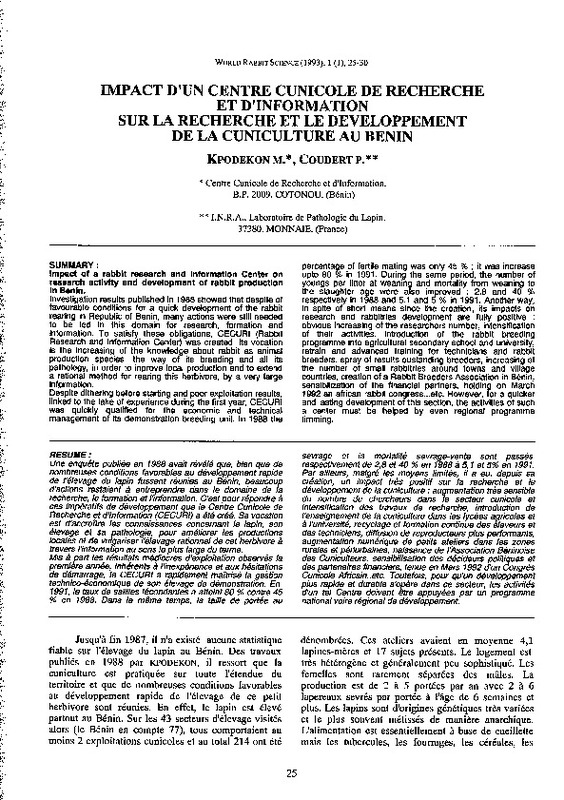JavaScript is disabled for your browser. Some features of this site may not work without it.
Buscar en RiuNet
Listar
Mi cuenta
Estadísticas
Ayuda RiuNet
Admin. UPV
IMPACT D'UN CENTRE CUNICOLE DE RECHERCHE ET D'INFORMATION SUR LA RECHERCHE ET LE DÉVELOPPEMENT DE LA CUNICULTURE AU BENIN
Mostrar el registro sencillo del ítem
Ficheros en el ítem
| dc.contributor.author | Kpodekon, M.
|
|
| dc.contributor.author | Coudert, P.
|
|
| dc.date.accessioned | 2011-03-23T13:11:28Z | |
| dc.date.available | 2011-03-23T13:11:28Z | |
| dc.date.issued | 1993 | |
| dc.identifier.issn | 1257-5011 | |
| dc.identifier.uri | http://hdl.handle.net/10251/10569 | |
| dc.description.abstract | [EN] lnvestigation results published in 1988 showed that despite of favourable conditions for a quick development of the rabbit rearing in Republic of Benin, many actions were still needed to be led in this domain for research, formation and information. To satisfy these obligations, CECURI (Rabbit Research and lnformation Center) was created. lts vocation is the increasing of the knowledge about rabbit as animal production species, the way of its breeding and all its pathology, in order to inprove local production and to extend a rational method for rearing this herbivore, by a very larga information. Despite dithering before starting and poor exploitation results, linked to the lake of experience during the first year, CECURI was quickly qualified for the economic and technical management of its demonstration breeding unit. In 1988 the percentage of fertile mating was only 45 % ; it was increase upto 80 % in 1991. During the sama period, the number of youngs per litter at weaning and mortality from weaning to the slaughter age were also improved : 2.8 and 40 % respectively in 1988 and 5.1 and 5 % in 1991. Another way, in spite of short means since the creation, its impacts on research and rabbitries development are fully positiva : obvious increasing of the researchers number, intensification of their activities, introduction of the rabbit breeding programme into agricultura! secondary school and university, retrain and advanced training for technicians and rabbit breeders, spray of results oustanding breeders, increasing of the number of small rabbitries around towns and village countries, creation of a Rabbit Breeders Association in Bénin, sensibilization of the financia! partners, holding on March 1992 an african rabbit congress ... etc. However, for a quicker and lasting development of this section, the activities of such a center must be helped by even regional programme timming. | es_ES |
| dc.description.abstract | [FR] RESUME: Une enquéte publiée en 1988 avait révélé que, bien que de nombreuses conditions favorables au développement rapide de l'élevage du tapín fussent réunies au Bénin, beaucoup d'actions restaient a entreprendre dans le domaine de la recherche, le formation et l'information. C'est pour répondre a ces impératifs de développement que le Centre Cunicole de Recherche et d'lnformation (CECURI) a été créé. Sa vocation est d'accroitre les connaissances concernant le tapín, son élevage et sa pathologie, pour améliorer les productions locales et de vulgariser l'élevage rationnel de cet herbivore a travers l'information au sens le plus large du terme. Mis a part les résultats médiocres d'exploitation observés la premiere année, inhérents a l'inexpérience et aux hésitations de démarrage, le CECURI a rapidement maitrisé la gestion technico-économique de son élevage de démonstration. En 1991, le taux de saillies fécondantes a atteint 80 % contre 45 % en 1988. Dans le méme temps, la taille de portée au sevrage et la mortalité sevrage-vente sont passés respectivement de 2,8 et 40 % en 1988a5,1et5% en 1991. Par ailleurs, malgré les moyens limités, il a eu, depuis sa création, un impact tres positif sur la recherche et te développement de la cuniculture : augmentation tres sensible du nombre de chercheurs dans le secteur cunicole et intensification des travaux de recherche, introduction de l'enseignement de la cuniculture dans les /ycées agricoles et a /'université, recyclage et formation continua des éleveurs et des techniciens, diffusion de reproducteurs plus performants, augmentation numérique de petits ateliers dans les zones rurales et périurbaines, naissance de l'Association Béninoise des Cuniculteurs, sensibilisation des décideurs politiques et des partenaires financiers, tenue en Mars 1992 d'un Congres Cunicole Africain .. etc. Toutefois, pour qu'un développement plus rapide et durable s'o~re dans ce secteur, les activités d'un te/ Centre doivent etre appuyées par un programme national voire régional de développement. | |
| dc.language | Francés | es_ES |
| dc.publisher | World Rabbit Science. ICTA. UPV | es_ES |
| dc.relation.ispartof | World Rabbit Science | |
| dc.rights | Reserva de todos los derechos | es_ES |
| dc.title | IMPACT D'UN CENTRE CUNICOLE DE RECHERCHE ET D'INFORMATION SUR LA RECHERCHE ET LE DÉVELOPPEMENT DE LA CUNICULTURE AU BENIN | es_ES |
| dc.type | Artículo | es_ES |
| dc.date.updated | 2011-03-23T13:02:24Z | |
| dc.identifier.doi | 10.4995/wrs.1993.192 | |
| dc.rights.accessRights | Abierto | es_ES |
| dc.description.bibliographicCitation | Kpodekon, M.; Coudert, P. (1993). IMPACT D'UN CENTRE CUNICOLE DE RECHERCHE ET D'INFORMATION SUR LA RECHERCHE ET LE DÉVELOPPEMENT DE LA CUNICULTURE AU BENIN. World Rabbit Science. 01(1). https://doi.org/10.4995/wrs.1993.192 | es_ES |
| dc.description.accrualMethod | SWORD | es_ES |
| dc.relation.publisherversion | https://doi.org/10.4995/wrs.1993.192 | |
| dc.description.volume | 01 | |
| dc.description.issue | 1 | |
| dc.identifier.eissn | 1989-8886 | es_ES |








